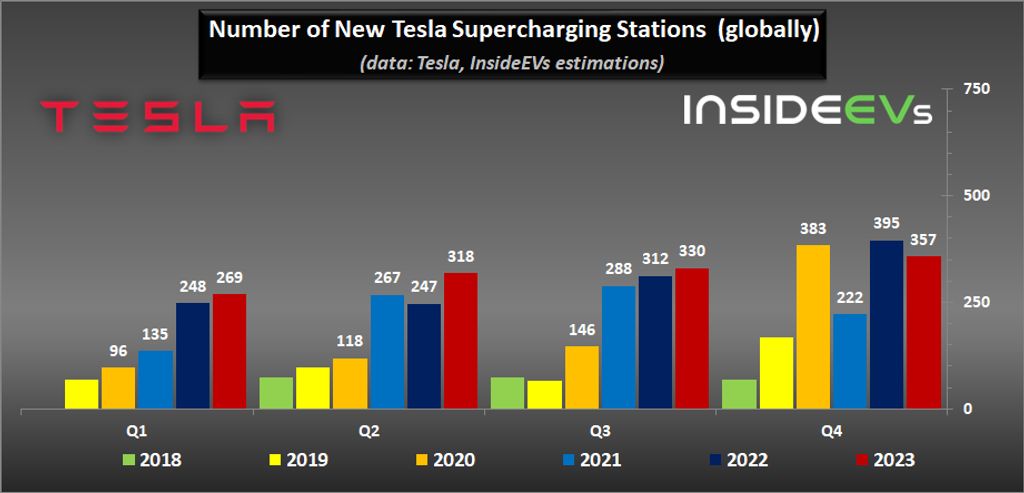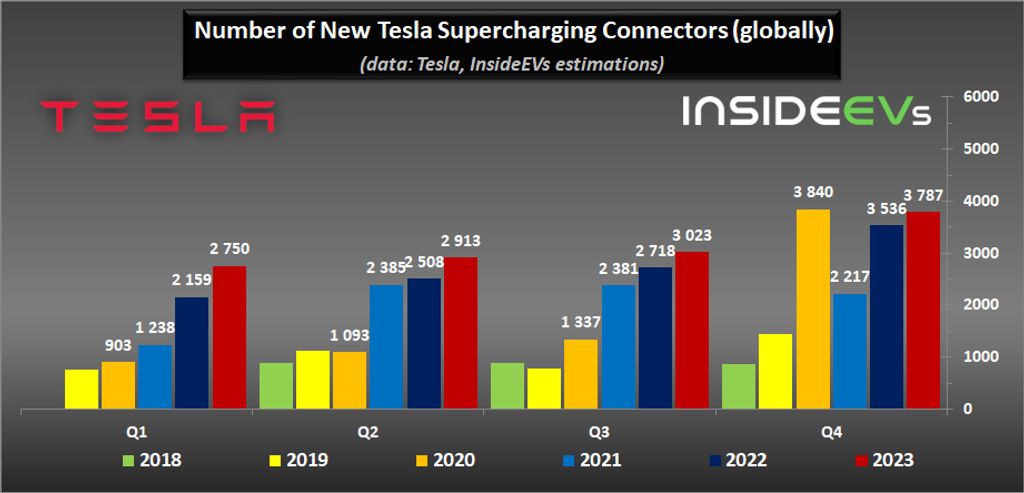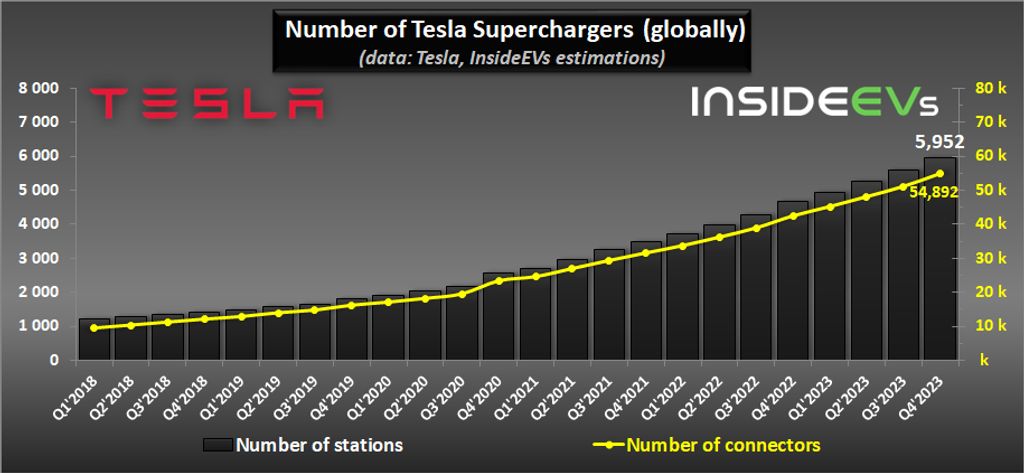During the fourth quarter of 2023, Tesla continued to expand its Supercharging network around the world at a near-record rate.
The number of new stations (deployed globally) amounted to 357 (down 10% year-over-year), which is the third highest quarterly result ever.
Get Fully Charged
6,000 Tesla Supercharging stations
At the end of 2023, the number of Tesla Supercharging stations (globally) exceeded 5,950. As of today, it’s almost certainly above 6,000, which makes it the largest EV fast charging network of its kind.
The number of new individual connectors in Q4 increased by 3,783 (up 7% year-over-year). That’s the second highest result ever. The average ratio of connectors per station amounted to 10.6 (compared to 9.0 a year ago).
The data confirms that for Tesla, the fourth quarters are the strongest when it comes to Superchargers deployment.
Tesla Supercharging network – Q4’2023 results (YOY change):
- New stations: 357 (down 10%)
- New individual connectors (stalls): 3,787 (up 7%)
- Connectors (stalls) per station on average: 10.6 (up 18%)
In 2023, Tesla installed more than 1,270 new Supercharging stations and over 12,400 individual stalls. In both cases, the numbers are record high, although the year-over-year is small (6% for stations and 14% for stalls).
Tesla Supercharging network – Q1-Q4’2023 results (YOY change):
- New stations: 1,274 (up 6%)
- New individual connectors (stalls): 12,473 (up 14%)
- Connectors (stalls) per station on average: 9.8 (up 8%)
When it comes to the current size of the network, it consists of roughly 6,000 stations and 55,000 individual charging stalls. That’s close to 30% more than a year ago.
Tesla Supercharging network – cumulative numbers (YOY change):
- New stations: 5,952 (up 27%)
- New individual connectors (stalls): 54,892 (up 29%)
- Connectors (stalls) per station on average: 9.2 (up 2%)
In September 2023, Tesla celebrated the installation of its 50,000th Supercharging stall, which happened to be a special one installed in California. Recently, it passed 55,000.
The number of Tesla Superchargers – stalls (globally):
- 1st: September 2012
- 10,000: June 2018
- 20,000: November 2020
- 30,000: November 2021 (+10,000 in 1 year)
- 35,000: June 10 2022 (+5,000 in roughly 7 months)
- 10 years: September 2012-2022
- Europe (10,000): October 5, 2022
- 40,000: November 22 2022 (+10,000 in 1 year)
- China (10,000): December 26, 2022
- 45,000: April 9, 2023 (+5,000 in less than 5 months, +10,000 in 10 months)
- 50,000: September 8, 2023 (+5,000 in roughly 5 months, +10,000 in less than 10 months)
- 55,000: January 4, 2024 (+5,000 in roughly 4 months)
If all of the 55,000+ stalls were powered simultaneously, at a 100 kW average (for illustrative purposes), the total output would be over 5.5 GW.
Non-Tesla Supercharging
Additionally, Tesla continues to expand the Non-Tesla Supercharger Pilot, which is available at select stations in some markets.
The non-Tesla pilot currently includes over 20 countries:
- North America:
- Europe and surrounding markets:
- Europe (18 countries) – Austria, Belgium, Denmark, Finland, France, Germany, Hungary, Iceland, Ireland, Italy, Luxembourg, The Netherlands, Norway, Romania, Spain, Sweden, Switzerland, United Kingdom
[Native compatibility with the CCS2 standard]
Additionally, to handle various EVs, new V4 stations are equipped with a longer cable - Turkey
[Native compatibility with the CCS2 standard]
- Europe (18 countries) – Austria, Belgium, Denmark, Finland, France, Germany, Hungary, Iceland, Ireland, Italy, Luxembourg, The Netherlands, Norway, Romania, Spain, Sweden, Switzerland, United Kingdom
- Asia Pacific:
To make the Superchargers more accessible to non-Tesla EV drivers, the new V4 stalls come with a contactless bank card reader and a small display. By equipping the chargers with these features, the Tesla app might not be needed to start a charging session in the future.
Supercharging Power
As of today, Tesla Superchargers offer a peak power output of up to 250 kW, but it’s expected to increase quite substantially.
In the past, there were reports about 300 kW and more in the future, and a rumor about 324 kW in the case of V3 Superchargers.
In 2023, Tesla launched its first V4 Superchargers in Europe. In the United States, the first V4 installations were spotted in a few states in October 2023 and launched that month. The V4s in the US are equipped with an integrated CCS1 adapter (aka Magic Dock), a credit card reader, and a small display, to handle non-Tesla EVs.
Tesla Superchargers peak output:
Separately, Tesla is building fast chargers for electric trucks (Tesla Semi) – known also as Tesla Megachargers), which are promised to offer a megawatt charging level.
Charging standards
In Q4 2022, Tesla announced the opening of its proprietary charging standard, which will be called the North American Charging Standard (NACS) and standardized as SAE J3400. In May 2023, Ford announced the switch from CCS1 to NACS in North America (starting in 2025). General Motors followed the move and, since then, multiple other EV manufacturers, charging networks, and charging equipment manufacturers announced support for NACS.
Separately, Tesla started to retrofit its chargers in North America with an integrated CCS1 adapter (aka Magic Dock) to charge electric vehicles compatible with the CCS Combo 1/J1772 Combo standard. A small number of such stations (V3) were already installed in 2023. The new V4 versions also are getting the Magic Dock.
In Europe (and most of the rest of the world), new Tesla cars are equipped with a CCS Combo 2 compatible charging inlet for both AC and DC charging.
In China, the company uses GB/T charging inlets (one for AC and one for DC charging).
Tesla Supercharging plugs vary depending on the market:
- North America (and some other markets, like South Korea, and Japan): a proprietary charging standard, named the North American Charging Standard (NACS) by Tesla
- With the Magic Dock (built-in CCS1 adapter), Supercharging stalls are able to charge CCS1-compatible, non-Tesla EVs
- Europe (and most of the rest of the world): CCS2-compatible charging standard
Initially, there was a different plug, compatible with AC Type 2 inlets, used by Tesla for DC charging (the inlet served 1- or 3-phase AC charging, as well as DC charging at Superchargers). With the launch of the Model 3 in Europe (and the following models – Model Y, refreshed Model S/Model X), Tesla switched to CCS2-compatible charging inlet, and retrofitted Superchargers with CCS2-compatible plugs for DC charging. Many of the Superchargers are now equipped with two different plugs, but the newer, CCS2-compatible is the way to go forward. - China: GB/T-compatible charging standard (two inlets on vehicle side: one for AC and one for DC charging)
Sales of chargers to other networks
The fourth quarter of 2023 revealed a very interesting move made by Tesla, which started sales of DC fast charging solutions to other charging networks around the world.
The first deal was announced in October 2023 with BP (BP Pulse network in the U.S. estimated at $100 million). In November 2023, EG Group announced the acquisition of Tesla’s electric vehicle ultra-fast chargers for its evpoint business in Europe.





